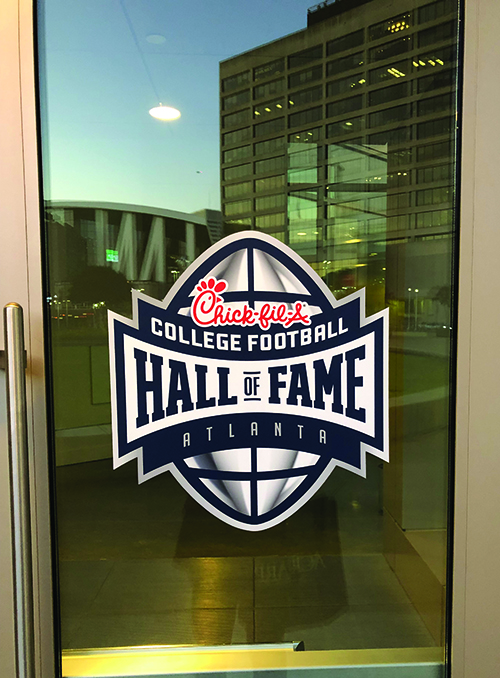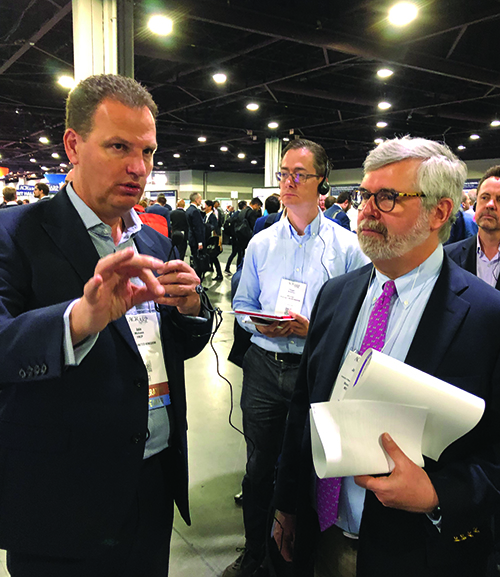Spring 2020 (Volume 30, Number 1)
ACR 2019 in Atlanta
By Philip A. Baer, MDCM, FRCPC, FACR
Download PDF
“I dare somebody to go to Atlanta and not have a good time."
– Brian Tyree Henry (actor and star of the show "Atlanta")
The last time the American College of Rheumatology’s (ACR) annual
scientific meeting was held in Atlanta was in 2010. Given that the ACR
has its corporate headquarters in Atlanta, I was surprised the meeting
is not held there more often. I missed ACR 2010 as we were on a CME trip in
China. However, as we queued for customs on our return at Toronto Pearson
airport, I noticed that I knew dozens of people in the snaking line. They were
all returning from ACR 2010, so I received a crash course on the meeting
highlights while we waited.
While I had transited through the Atlanta airport, I had never
actually been to the city. In addition to the conference at the
Georgia World Congress Centre, I was hoping to see some of
the city’s highlights, including the headquarters of CNN and
Coca-Cola, as well as the Chik-Fil-A College Football Hall of
Fame (CCFHF). Despite the recent controversy surrounding the
opening of a Chik-Fil-A restaurant in Toronto, the CRA chose
to hold Canada Night at CCFHF, and the combination of colleagues,
food, wine and the exhibits turned out to be a winner.
Most of my other touristy plans went up in smoke, as the
conference agenda is so busy. This is a product of its own merits
(over 15,000 participants and nearly 11,000 scientific attendees
from 103 countries, thousands of posters, hundreds
of podium presentations, and many very interesting lectures),
and because it provides a venue for all sorts of other meetings
to take place on the sidelines with colleagues from across Canada and
around the world.
For those trying to get organized, the ACR meeting app was very helpful. I
signed up for daily poster tours as well, which provide the views of an expert
on key studies in various disease areas. I focused on rheumatoid arthritis (RA),
enjoying small-group interaction with leaders such as Dr. Jonathan Kay and
Professor Iain McInnes (see photo at top on page 9). I highly commend the
attempts by ACR to make learning more fun and interactive, including the
ACR Knowledge Bowl (won by the defending champion Neutrophil Nets with
a highly vocal cheering section), The Great Debate, and Thieves Markets. The
Great Debate proposition this year was “Anabolic agents are/are not appropriate
first-line therapy for glucocorticoid-induced osteoporosis.” This was timely
given the recent approval of romosozumab in both Canada and the US, and
the 2017 approval of abaloparitide in the U.S., in addition to the long-available
teriparatide. New features included a Daily Digest wrap-up presentation which
synthesized significant findings from the multiple concurrent sessions of the
day. The roster of well-known speakers for this segment included Joe Craft,
David Isenberg, Cornelia Weyand, Peter Merkel, Marian Hannan and Gregg
Silverman. I also enjoyed the TED-style talks at the “In the Rheum” discussion,
with Iain McInnes, John Stone and Liz Lightstone. The theme of minimizing steroid use in
RA, lupus and vasculitis was intriguing and looks more feasible with advances in therapies. There was also a daily #ACR19 Tweet Up highlighting diverse participants’ views on key topics and studies.
The kickoff Year in Review session is always worthwhile, as is the end of the conference summary with Jack Cush and Artie Kavanagh. Between them, they wished for fewer presentations on fibromyalgia (not wanting to paint rheumatologists as the subject matter experts) and on hydroxychloroquine drug monitoring. New ACR Guidelines were presented on gout, osteoarthritis (OA) of the hip, knee and hand, large vessel vasculitis (giant cell arteritis [GCA], polyarteritis nodosa [PAN] and Takayasu), and antineutrophil cytoplasmic antibody (ANCA)-associated vasculitis. The gout guideline championed Treat-to-Target over the Treat-to-Symptom Control advocated by other organizations. For osteoarthritis (OA), the term “nonpharmacologic” is on the way out, replaced by more positive terms to describe these essential therapies.
The Phillip Hench lecture by John Reveille was a tour
de force on axial spondyloarthritis (SpA), B27 and personalized
medicine. I heard the Immunology and Stats boot
camp sessions were also excellent, but there isn’t time to
attend every session personally. I also enjoyed the European
League Against Rheumatism (EULAR) session on “The
Road to Remission is Long and Bumpy, but Worth it in the
End,” featuring the ever-present and always entertaining
Iain McInnes.
The ACR makes catching up easy, with free access to all
sessions for all registrants for one year after the conference
through ACR Beyond. This now includes videos, syllabi,
and downloadable highlight slides. CME credits were much
easier to document this year. They were even available for
those who paid a registration fee and watched the conference
from home via live streaming.
Late-breaking, pediatric, and patient perspective posters
have gone digital, and were presented as e-posters which can
also be viewed on the ACR website. Late-breaking abstracts
covered a variety of novel therapies from anifrolumab and
fenebrutinib for lupus to olokizumab for RA. Time will tell if
these and other innovative therapies make it to our clinics.
Late-breaking, pediatric, and patient perspective posters
have gone digital, and were presented as e-posters which can
also be viewed on the ACR website. Late-breaking abstracts
covered a variety of novel therapies from anifrolumab and
fenebrutinib for lupus to olokizumab for RA. Time will tell if
these and other innovative therapies make it to our clinics.
Highlights:
Best session title: “You Give Me Fever: Case-based Approach
to Autoinflammatory Syndromes.”
The usual suspects were well-represented in abstracts:
JAK inhibitors, adverse events of checkpoint inhibitors, comorbidities
in rheumatic diseases, and FDA updates.
Abstracts presented at ACR plenary sessions included
guselkumab in psoriatic arthritis (PsA), long-term GIACTA
study results, methotrexate (MTX) in erosive hand OA,
prednisolone in hand OA, anifrolumab in systemic lupus erythematosus
(SLE), ixekizumab in non-radiographic AxSpA,
upadacitinib in ankylosing spondylitis (AS), and romosozumab
for osteoporosis in patients with kidney disease.
I had one poster this year, but I was interested to see
that I was one of four Baers with abstracts–the others were
Rebecca with two, Alan and Jean. None of us were related to
any one of the others, as far as I can discern.
“Medical Education Beyond Rheumatology In 2019” included
clinical sessions which explored non-rheumatologic
diseases rheumatologists often encounter in their patients.
For instance, the “NAFLD (non-alcoholic fatty liver disease)
& Hepatotoxic Medications: What’s a Rheumatologist to
Do?” session covered non-alcoholic steato-hepatitis, and
the medications we can and can’t use with our patients who
have this condition.
The strong Canadian contingent included Meet the
Professor session leader Nigil Haroon, and workshop leaders
Pari Basharat and Johannes Roth. Many Canadians also
moderated sessions and presented their research findings.
Ron Laxer and Hani el-Gabalawy were recognized as ACR
Masters.
The next ACR meeting will be in Washington, D.C. in November
2020, just after the U.S. presidential election. That
should be an exciting meeting. I look forward to seeing you
there.




Dr. lain McInnes and Dr. Jonathan Kay

Philip A. Baer, MDCM, FRCPC, FACR
Editor-in-chief, CRAJ
Scarborough, Ontario
|
